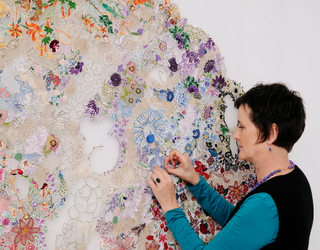
Louise Saxton was our first resident from Australia. Her work with reclaimed embroidery is truly unique and you will enjoy her thought provoking interview.
You work with reclaimed embroidery. Please tell us what you mean by that.
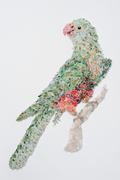 My main art material over the past nine years is discarded needlework, which is primarily vintage or antique hand-made embroidery and lace. Doilies, tablecloths, bed linen and clothing, which were painstakingly and lovingly made for functional and aesthetic domestic purposes in previous eras, are now culturally redundant in our ‘throw-away’ contemporary world. I use the term “reclaimed” as I am claiming the original domestic objects for a new purpose. I rescue these materials from charity/thrift shops and markets and I am fortunate that friends, family and even strangers also contribute needlework to my collection.
My main art material over the past nine years is discarded needlework, which is primarily vintage or antique hand-made embroidery and lace. Doilies, tablecloths, bed linen and clothing, which were painstakingly and lovingly made for functional and aesthetic domestic purposes in previous eras, are now culturally redundant in our ‘throw-away’ contemporary world. I use the term “reclaimed” as I am claiming the original domestic objects for a new purpose. I rescue these materials from charity/thrift shops and markets and I am fortunate that friends, family and even strangers also contribute needlework to my collection.
Tell us about the path you took to the reclaimed embroidery work you are doing.
My art school training was in drawing, painting and printmaking, but over the past nineteen years ‘the home’ has been central to my art practice. While I have no formal training in textiles, I grew up in a family where making things by hand was valued and textiles were at the centre of domestic productivity and creativity. My mother was an avid knitter and excellent dressmaker and she taught me to sew and knit my own clothes. Also, my Nana constantly crocheted. It’s interesting to reflect on my childhood in relation to my current practice in combining my use of reclaimed textiles with my reinterpretation of historical imagery. As a teenager I reinterpreted a number of my mother’s vintage knitting patterns from the 1930’s and 40’s. By knitting the garments in high-key colours popular in the 1970’s I was contemporising, while keeping alive, the exquisite patterns of an earlier era. This is what I am trying to do in my practice today – to reinvigorate and also restore value to the exquisite needlework and pay homage to the artisan needleworkers of the past.
You work with pins more than stitching. Tell us why and how this technique developed.
 I rarely stitch down any of my textiles, although I have in the past used a vintage sewing machine to stitch the reclaimed needlework to layers of tulle and silk. Now I primarily use stainless steel or brass lace-pins to hold the textile fragments in place. This adds a sculptural element to the relief-work, as there are countless pins in each assemblage. In the case of my bird imagery in particular, the pins add a sense of light shimmering on the feathers.
I rarely stitch down any of my textiles, although I have in the past used a vintage sewing machine to stitch the reclaimed needlework to layers of tulle and silk. Now I primarily use stainless steel or brass lace-pins to hold the textile fragments in place. This adds a sculptural element to the relief-work, as there are countless pins in each assemblage. In the case of my bird imagery in particular, the pins add a sense of light shimmering on the feathers.
The pins also have significance beyond their practical use in their fascinating and gruesome historical origins and also in what they may represent metaphorically and conceptually in terms of pain. This includes the painstaking labour of needlework traditions and the pain of loss associated with disappearing traditions and species in the natural world. I am also interested in the fact that during the industrial revolution the ‘pointers’ whose sole job it was to grind the head of the pin, inhaled the tiny shards of metal and acquired a deadly lung disease known as pointer’s rot.
I have developed calluses on my fingers from all the pinning, unpinning and re-pinning it takes to make each of my pieces and every time I get a pin prick, it is a sharp reminder of the pain associated with these traditions over the centuries.
 What have you learned about embroidery and other needlework traditions that you can share with our readers?
What have you learned about embroidery and other needlework traditions that you can share with our readers?
Needlework is an ancient art form, beautiful as well as practical, and whether simple or complex in design it is painstakingly constructed. Historically, handmade embroidery and lace were as economically valuable as gold and silver. Many cultures have needlework traditions and it has often been the burden of the poor to create exquisite garments for royalty and nobility. Even in indigenous cultures which don’t embroider or make lace, there is often exquisitely woven baskets and other vessels, or intricately woven or beaded clothing and headdress. Needlework is cross-cultural, but sadly in most parts of the world today, it is in danger of disappearing.
As the first Australian to attend 360 Xochi Quetzal, tell us what drew you to a residency in Mexico.
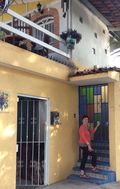 Initially, I was drawn to the residency by a stunning photo of Lake Chapala under the spell of a magnificent sunset, which was posted on Textile Fibre Forum’s online newsletter, with the heading “Free Artist Residency in Mexico”. What drew me to the residency in relation to my own practice was the fact that Mexico still has a living tradition of embroidery, albeit a fragile one. I also found it fascinating that the residency was named for the goddess of artisans, Xochi Quetzal, and in particular she is the protector of embroiderers and weavers!
Initially, I was drawn to the residency by a stunning photo of Lake Chapala under the spell of a magnificent sunset, which was posted on Textile Fibre Forum’s online newsletter, with the heading “Free Artist Residency in Mexico”. What drew me to the residency in relation to my own practice was the fact that Mexico still has a living tradition of embroidery, albeit a fragile one. I also found it fascinating that the residency was named for the goddess of artisans, Xochi Quetzal, and in particular she is the protector of embroiderers and weavers!
On a practical level I was drawn to apply because the program offered a self-contained living/working environment, which looked (and indeed was) very comfortable and aesthetically inspiring. The location on the largest freshwater lake in Mexico, with an abundance of bird life was also a wonderful draw. The fact that the residency is sponsored and run by North Americans also made it very accessible, as I don’t speak Spanish.
What were some of the highlights of your residency?
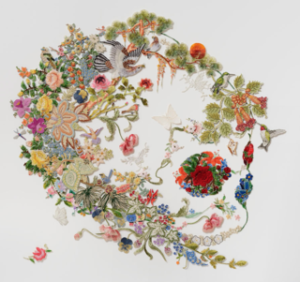 The opportunity to live and work in Mexico for a month and experience another language and culture every day; to spend time with other artists connected to the residency and make connections with some local artisans; to seek out and acquire (with much support from the residency patrons and other knowledgeable people in Chapala) some exquisite embroidery for my collection. I was also able to commission three Mexican flowers embroidered in silk by an artisan in the nearby pueblo of Ajijic. Along with the exquisite and rare Tehuantapec embroidery I purchased in Tlaquepaque, my collection and my next body of work, have been greatly enriched.
The opportunity to live and work in Mexico for a month and experience another language and culture every day; to spend time with other artists connected to the residency and make connections with some local artisans; to seek out and acquire (with much support from the residency patrons and other knowledgeable people in Chapala) some exquisite embroidery for my collection. I was also able to commission three Mexican flowers embroidered in silk by an artisan in the nearby pueblo of Ajijic. Along with the exquisite and rare Tehuantapec embroidery I purchased in Tlaquepaque, my collection and my next body of work, have been greatly enriched.
 What can you tell us about the work in your upcoming show at Gould Galleries in Melbourne?
What can you tell us about the work in your upcoming show at Gould Galleries in Melbourne?
My second solo show at Gould Galleries will be in November 2015. Is the celebration of flora – its glorious variety, colour, form, its strength and fragility. I continue my use of reclaimed needlework (and other materials) including antique textiles purchased in Mexico, to make a link between the domestic archives of home and the public archives of the museum and, to draw attention to the loss of domestic art traditions and species in the natural world.
Read more: http://gouldgalleries.com/Artists/tabid/80/ctl/ArtistDetails/mid/408/aid/1118/Default.aspx
What could be improved in the 360 Xochi Quetzal residency program?
I really could not fault the program for anything, as it was so supportive and inspiring. We were each provided with a beautiful, self-contained casita in a fabulous location, a food allowance, good Internet and an entre into a community of interesting people associated with the residency program. We were given an opportunity to relax, explore and work as we each desired. We were given the opportunity to have fun and form new friendships, through art and immersion in the vibrant life that is Chapala, Jalisco, Mexico! My heartfelt gratitude goes to Deborah and Christian for this inspiring, once in a lifetime opportunity.
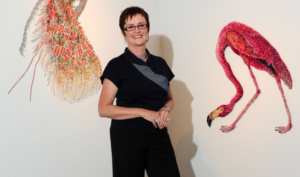 See more of Louise’s art on her website: www.louisesaxton.com
See more of Louise’s art on her website: www.louisesaxton.com
Read more about Louise in Textile Fibre Forum: Louise was recently interviewed in Textile Fibre Forum, the premier textile magazine in Austrailia. To read her interview, order a back copy of issue No. 117, Spring 2015: http://artwearpublications.com.au/back-issues.html?p=9
